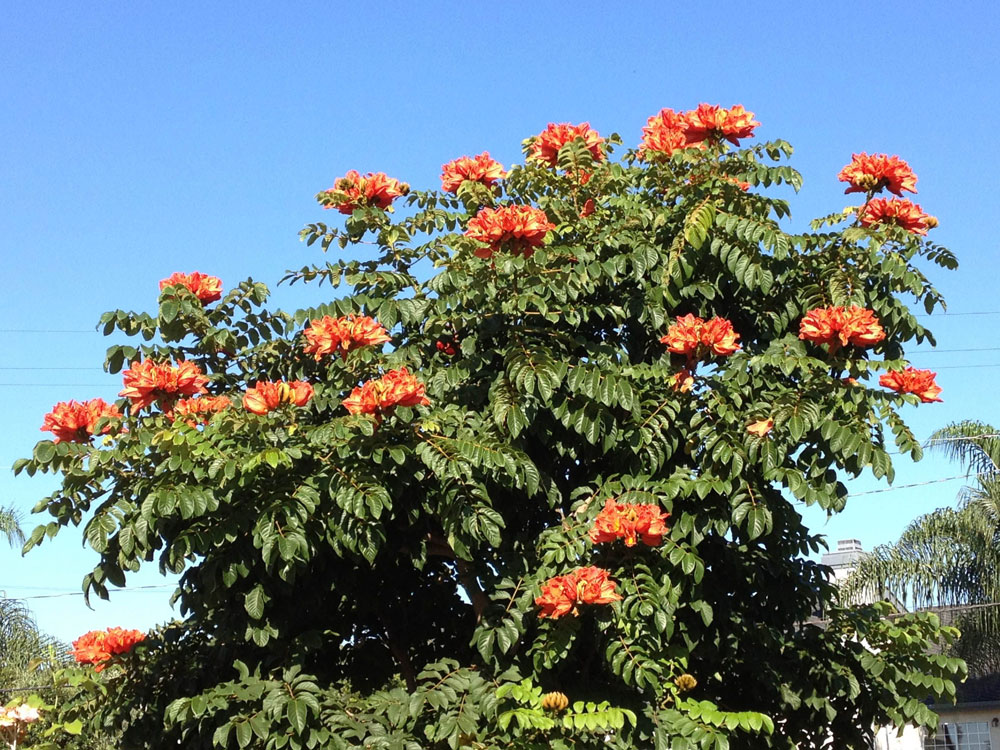Neerukayi Mara - African Tulip Tree

Spathodea campanulata
Summary
Scientific Classification
Kingdom: Plantae
Division: Angiosperm
Class: Dicotyledonae
Order: Lamiales
Family: Bignoniaceae
Genus: Spathodea
Species: S.campanulata
Scientific Name: Spathodea campanulata P.Beav.
Common Names:
English: African tulip tree, fountain tree, Nandi flame, Nile flame, squirt tree, Tulip tree, Uganda flame, Scarlet Bell.
Hindi: Rugtoora.
Kannada: Neerukayi mara.
Description:
- Habit and Habitat: A very handsome tree,One of the world’s most spectacular flowering trees, African tulip tree is a large upright tree with glossy deep green pinnate leaves and glorious orange scarlet flowers. It may grow to 80 ft on an ideal site, but most specimens are much smaller. The tree has a stout, tapering, somewhat buttressed trunk covered in warty light gray bark.African Tulip Tree is a large tree that can reach 50 ft in height.a large tree with large compound leaves arranged in pairs along the branches.
- Distribution: It is native to tropical dry forests of Africa. It has been nominated as among 100 of the “World’s Worst” invaders.This tree is planted extensively as an ornamental tree throughout the tropics,It has become an invasive species in many tropical areas such as Hawaii, Queensland (Australia), Fiji, Papua New Guinea, and intermediate zones of Sri Lanka, India.
- Morphology:
Leaf: Opposite, imparipinnate, leaflets 9-19, oval, pointed, with 2 or 8 fleshy glands.The 1-2 ft long opposite leaves, which emerge a bronzy color, are massed at the ends of the branches. They are composed of 5-19 deeply veined oval leaflets.
Inflorescence: Many flowered terminal racemes.
Flower: Orange-scarlet coloured, calyx boat-shaped, spathaceous, recurved, covers the flower in bud and then splits on one side and curves back, it has water secreting glands inside and contains water.Corolla large campanulate and swollen with ovate, wavy lobes.
Androecium: Stamens 4, exserted, yellow, anthers pendant.
Gynoecium: Disk large, cup shaped.Ovary oblong, ovules many.
Fruit: Capsule oblong-lanceolate, pointed at both ends.
Seeds: seeds winged.
Flowering and Fruiting Time: Decemer – March. - Propagation: Propagation is usually from seed, which can be variable. From herbaceous stem cuttings,from softwood cuttings,from semi-hardwood cuttings,from seed; sow indoors before last frost.
- Importance:
The bark has laxative and antiseptic properties, and the seeds, flowers and roots are used as medicine. The bark is chewed and sprayed over swollen cheeks. The bark may also be boiled in water used for bathing newly born babies to heal body rashes. Commonly planted in the gardens or as an avenue tree on roads. It’s a fine decorative tree. - Location: Anant Manohar Garden, Campus avenue, BCA surrounding sports ground surroundings.
 Trees of GSS Project supported by Makerspace Belgaum Website concept and designe by
Trees of GSS Project supported by Makerspace Belgaum Website concept and designe by